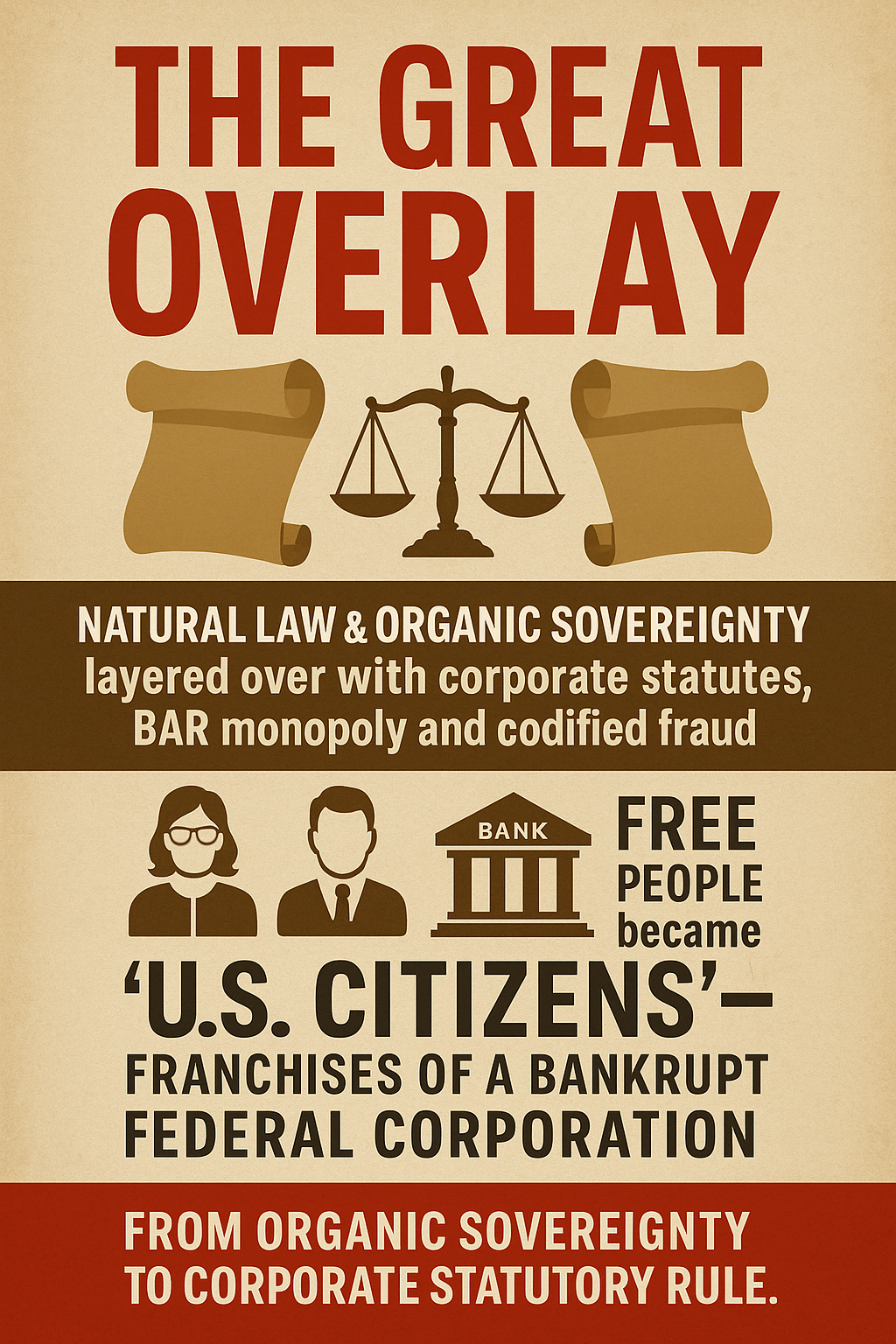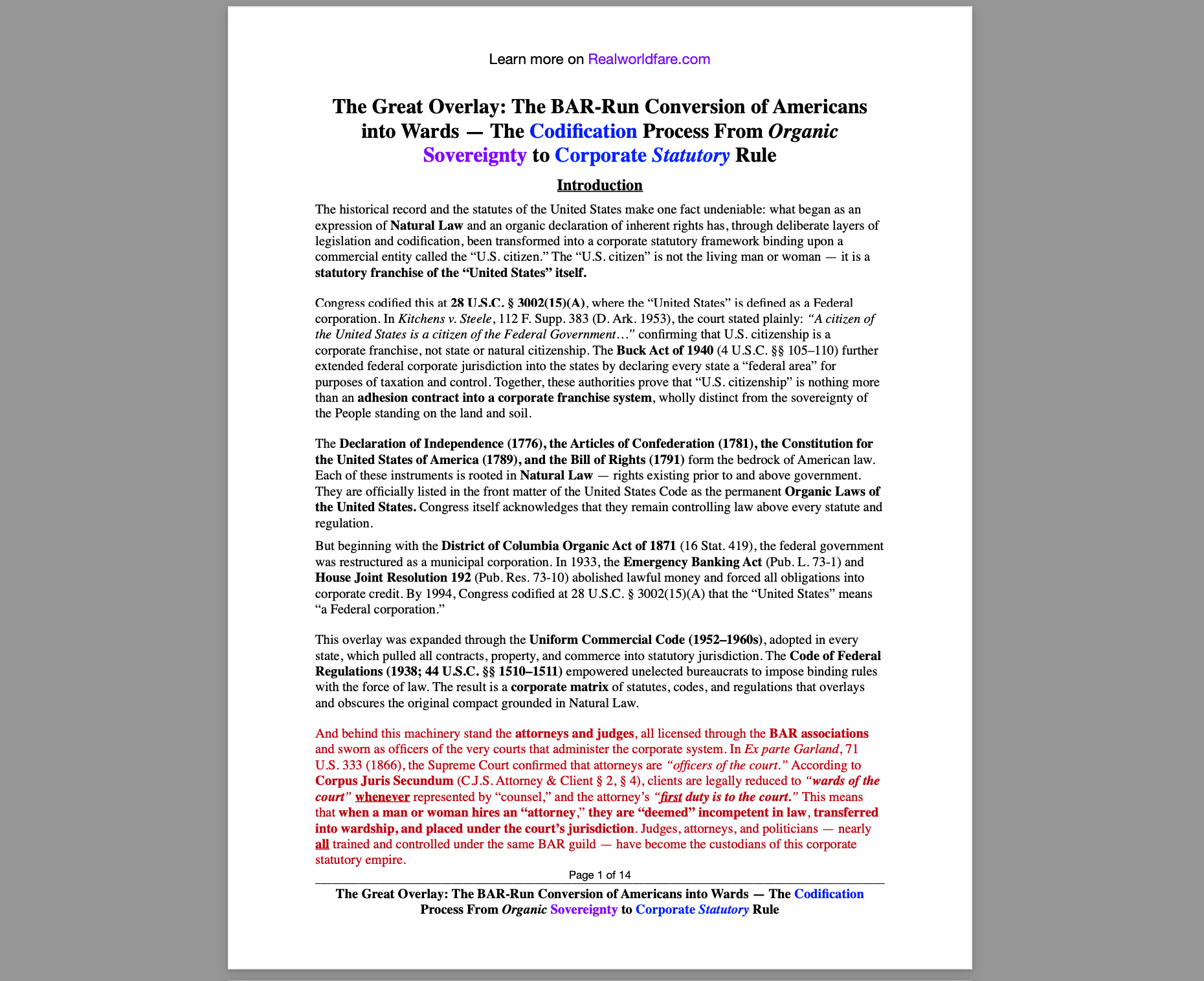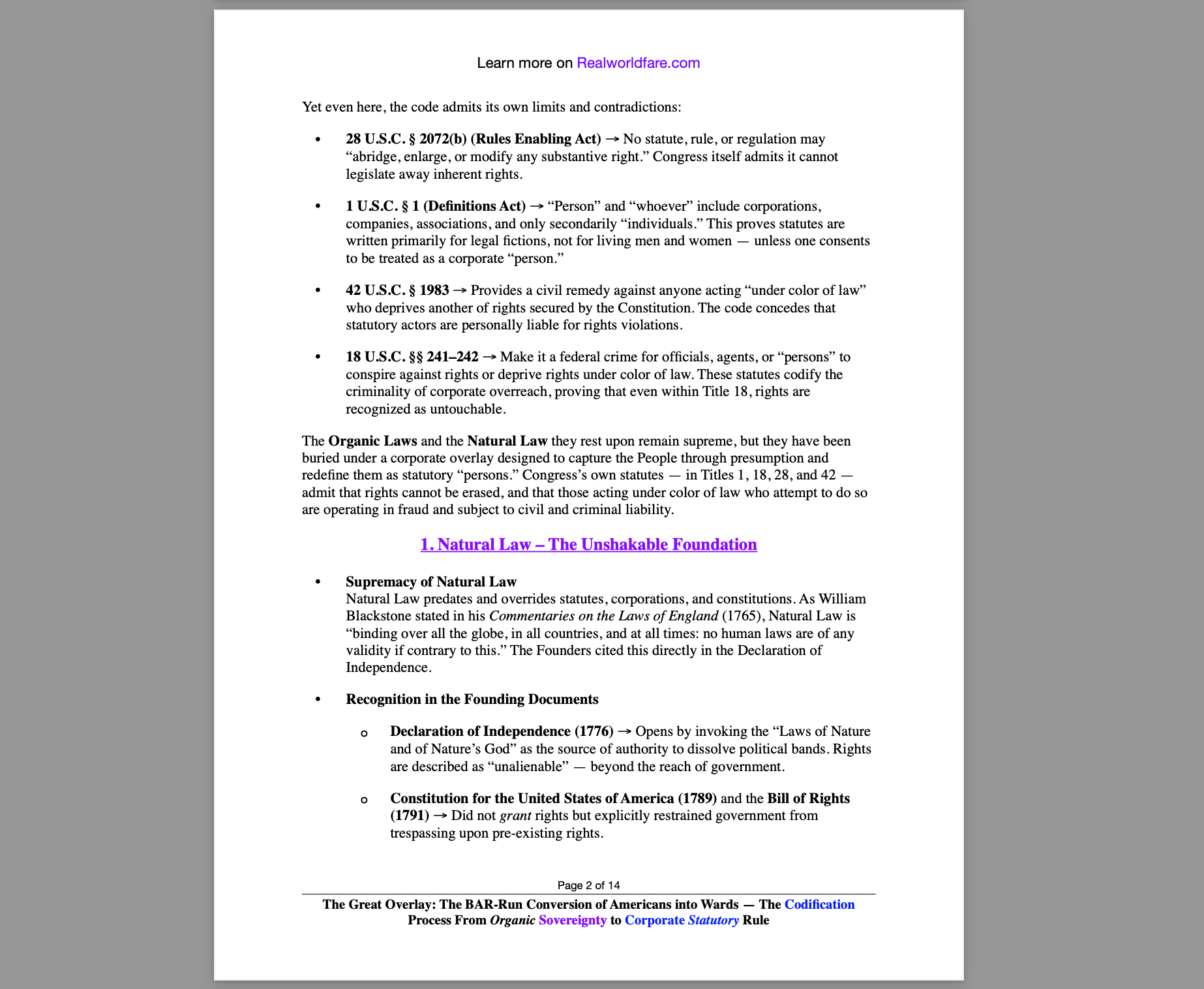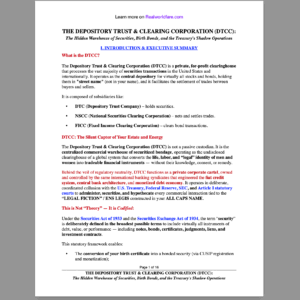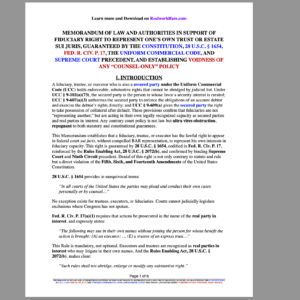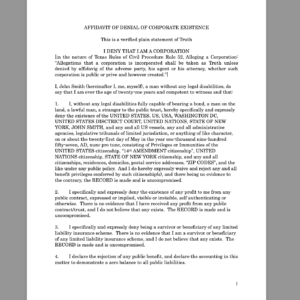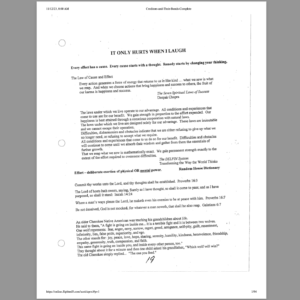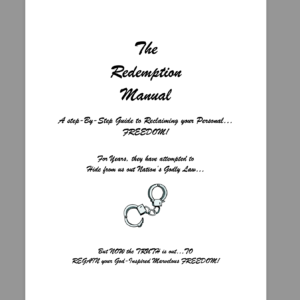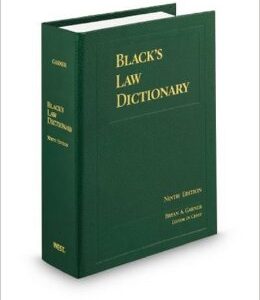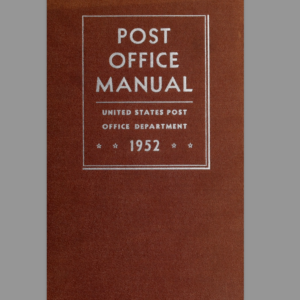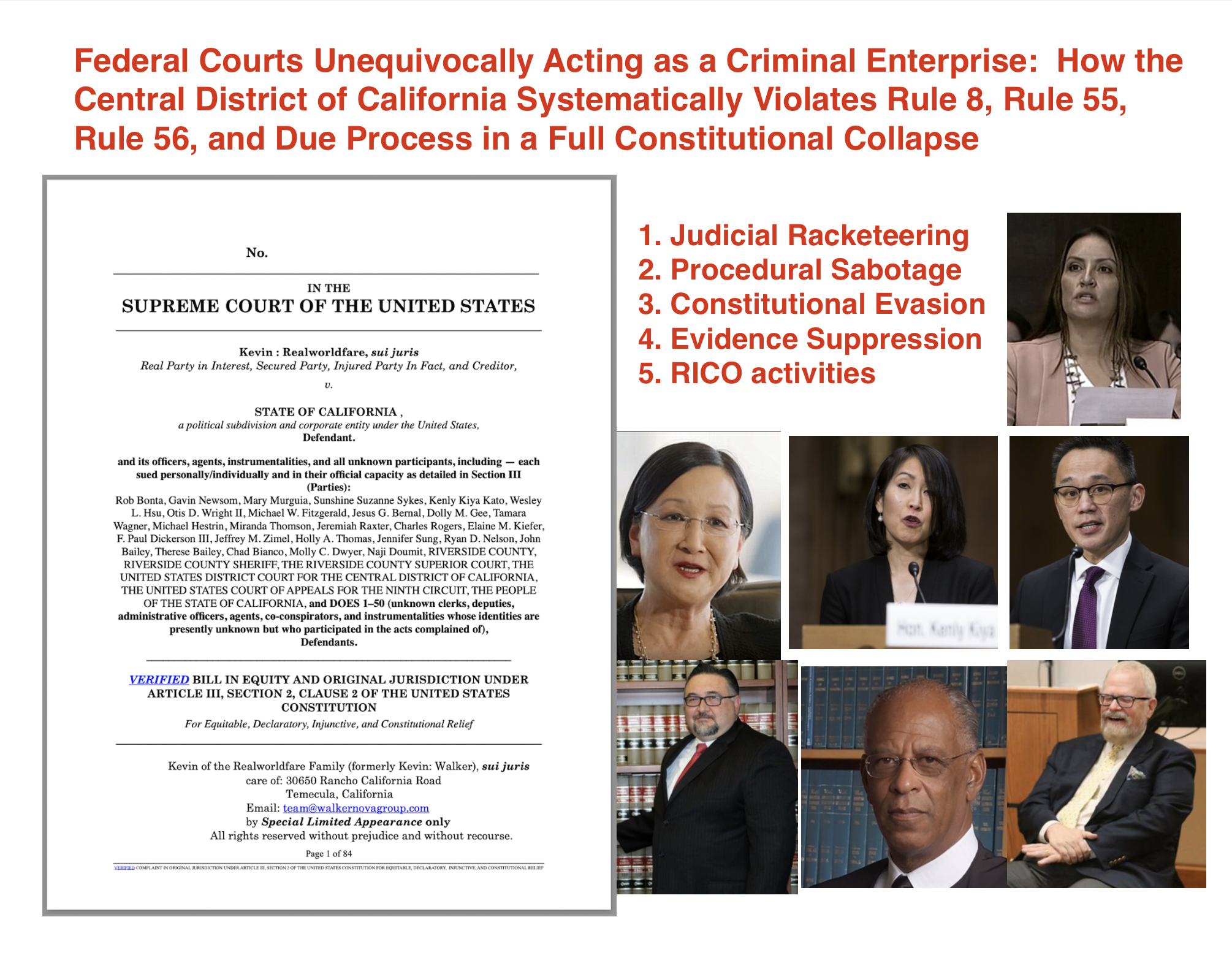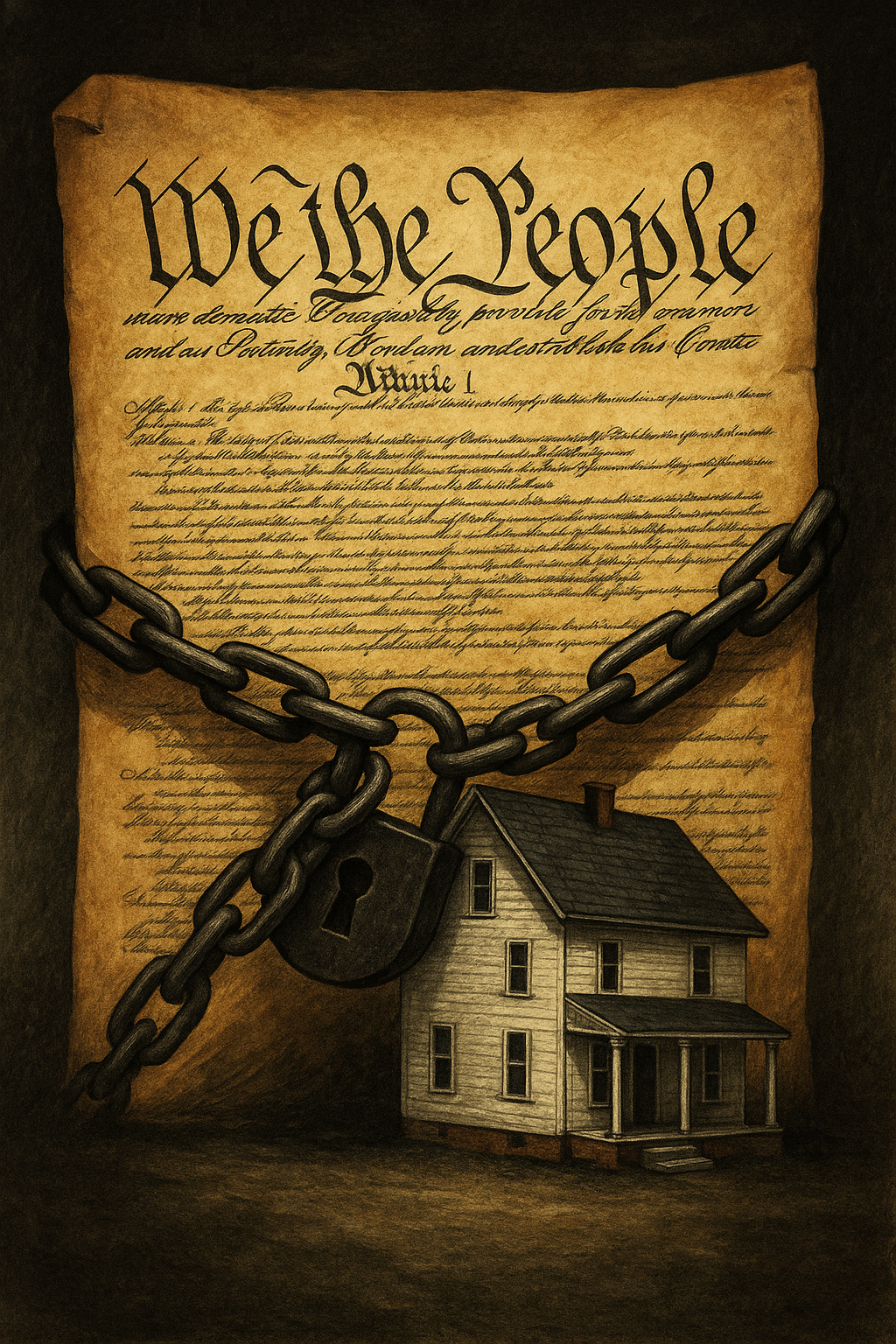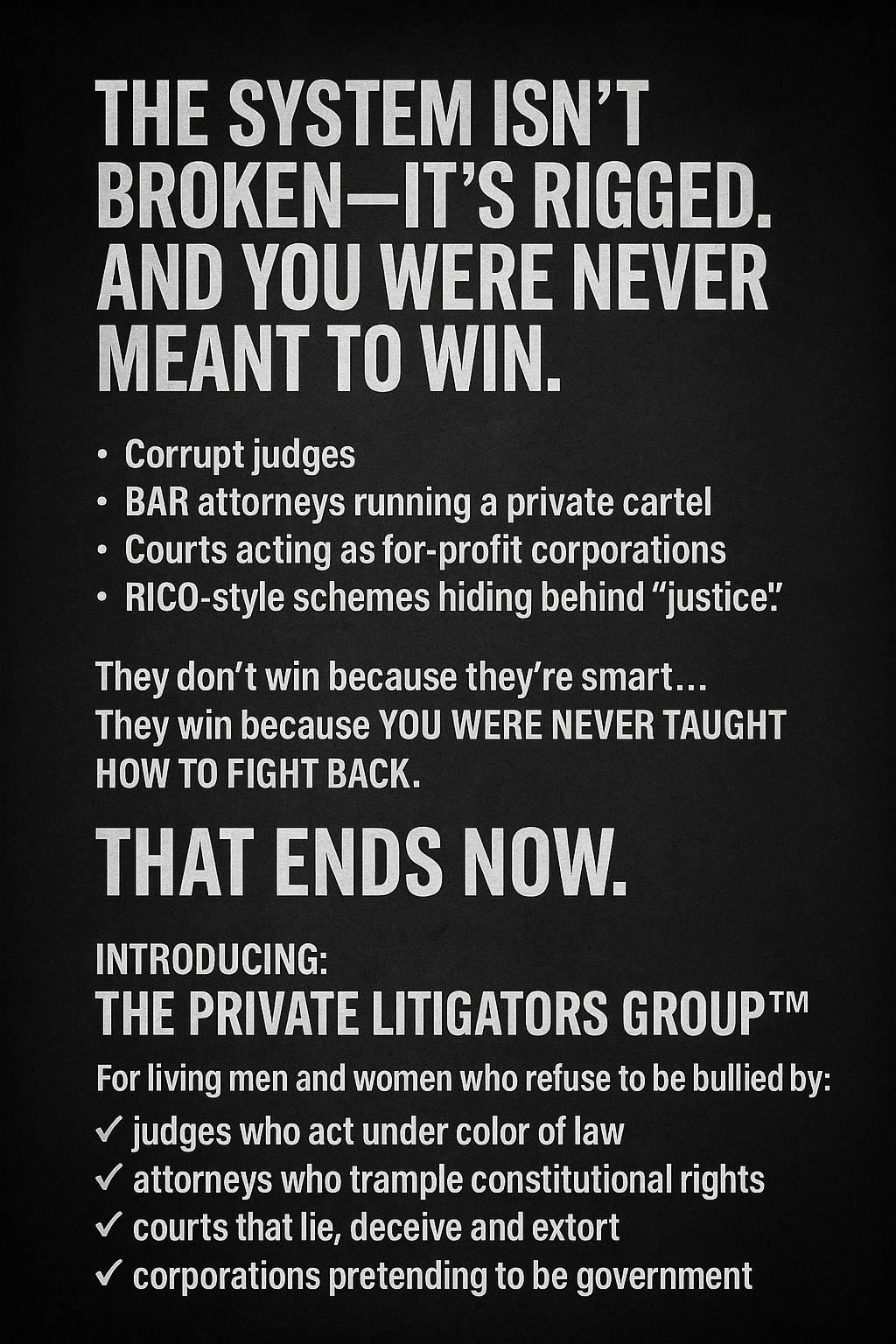Introduction
The historical record and the statutes of the United States make one fact undeniable: what began as an expression of Natural Law and an organic declaration of inherent rights has, through deliberate layers of legislation and codification, been transformed into a corporate statutory framework binding upon a commercial entity called the “U.S. citizen.” The “U.S. citizen” is not the living man or woman — it is a statutory franchise of the “United States” itself.
Congress codified this at 28 U.S.C. § 3002(15)(A), where the “United States” is defined as a Federal corporation. In Kitchens v. Steele, 112 F. Supp. 383 (D. Ark. 1953), the court stated plainly: “A citizen of the United States is a citizen of the Federal Government…” confirming that U.S. citizenship is a corporate franchise, not state or natural citizenship. The Buck Act of 1940 (4 U.S.C. §§ 105–110) further extended federal corporate jurisdiction into the states by declaring every state a “federal area” for purposes of taxation and control. Together, these authorities prove that “U.S. citizenship” is nothing more than an adhesion contract into a corporate franchise system, wholly distinct from the sovereignty of the People standing on the land and soil.
The Declaration of Independence (1776), the Articles of Confederation (1781), the Constitution for the United States of America (1789), and the Bill of Rights (1791) form the bedrock of American law. Each of these instruments is rooted in Natural Law — rights existing prior to and above government. They are officially listed in the front matter of the United States Code as the permanent Organic Laws of the United States. Congress itself acknowledges that they remain controlling law above every statute and regulation.
But beginning with the District of Columbia Organic Act of 1871 (16 Stat. 419), the federal government was restructured as a municipal corporation. In 1933, the Emergency Banking Act (Pub. L. 73-1) and House Joint Resolution 192 (Pub. Res. 73-10) abolished lawful money and forced all obligations into corporate credit. By 1994, Congress codified at 28 U.S.C. § 3002(15)(A) that the “United States” means “a Federal corporation.”
This overlay was expanded through the Uniform Commercial Code (1952–1960s), adopted in every state, which pulled all contracts, property, and commerce into statutory jurisdiction. The Code of Federal Regulations (1938; 44 U.S.C. §§ 1510–1511) empowered unelected bureaucrats to impose binding rules with the force of law. The result is a corporate matrix of statutes, codes, and regulations that overlays and obscures the original compact grounded in Natural Law.
And behind this machinery stand the attorneys and judges, all licensed through the BAR associations and sworn as officers of the very courts that administer the corporate system. In Ex parte Garland, 71 U.S. 333 (1866), the Supreme Court confirmed that attorneys are “officers of the court.” According to Corpus Juris Secundum (C.J.S. Attorney & Client § 2, § 4), clients are legally reduced to “wards of the court” whenever represented by “counsel,” and the attorney’s “first duty is to the court.” This means that when a man or woman hires an “attorney,” they are “deemed” incompetent in law, transferred into wardship, and placed under the court’s jurisdiction. Judges, attorneys, and politicians — nearly all trained and controlled under the same BAR guild — have become the custodians of this corporate statutory empire.
Yet even here, the code admits its own limits and contradictions:
- 28 U.S.C. § 2072(b) (Rules Enabling Act) → No statute, rule, or regulation may “abridge, enlarge, or modify any substantive right.” Congress itself admits it cannot legislate away inherent rights.
- 1 U.S.C. § 1 (Definitions Act) → “Person” and “whoever” include corporations, companies, associations, and only secondarily “individuals.” This proves statutes are written primarily for legal fictions, not for living men and women — unless one consents to be treated as a corporate “person.”
- 42 U.S.C. § 1983 → Provides a civil remedy against anyone acting “under color of law” who deprives another of rights secured by the Constitution. The code concedes that statutory actors are personally liable for rights violations.
- 18 U.S.C. §§ 241–242 → Make it a federal crime for officials, agents, or “persons” to conspire against rights or deprive rights under color of law. These statutes codify the criminality of corporate overreach, proving that even within Title 18, rights are recognized as untouchable.
The Organic Laws and the Natural Law they rest upon remain supreme, but they have been buried under a corporate overlay designed to capture the People through presumption and redefine them as statutory “persons.” Congress’s own statutes — in Titles 1, 18, 28, and 42 — admit that rights cannot be erased, and that those acting under color of law who attempt to do so are operating in fraud and subject to civil and criminal liability.
1. Natural Law – The Unshakable Foundation
- Supremacy of Natural Law
Natural Law predates and overrides statutes, corporations, and constitutions. As William Blackstone stated in his Commentaries on the Laws of England (1765), Natural Law is “binding over all the globe, in all countries, and at all times: no human laws are of any validity if contrary to this.” The Founders cited this directly in the Declaration of Independence. - Recognition in the Founding Documents
- Declaration of Independence (1776) → Opens by invoking the “Laws of Nature and of Nature’s God” as the source of authority to dissolve political bands. Rights are described as “unalienable” — beyond the reach of government.
- Constitution for the United States of America (1789) and the Bill of Rights (1791) → Did not grant rights but explicitly restrained government from trespassing upon pre-existing rights.
- Statutory Admissions
Even Congress admits it cannot erase rights:- 28 U.S.C. § 2072(b) (Rules Enabling Act): “Such rules shall not abridge, enlarge or modify any substantive right.”
- 42 U.S.C. § 1983 (Civil Rights Act of 1871): Provides liability against anyone who, “under color of any statute, ordinance, regulation, custom, or usage,” deprives another of rights secured by the Constitution.
- 18 U.S.C. § 241–242 (Civil Rights Crimes): Criminalizes conspiracies and acts “under color of law” that deprive rights. The very existence of these statutes proves rights are recognized as higher than government power.
- Judicial Admissions
The U.S. Supreme Court has repeatedly acknowledged the supremacy of Natural Law and the limits of statutes:- Calder v. Bull, 3 U.S. (3 Dall.) 386, 388 (1798) → Justice Chase: “An act of the Legislature (for I cannot call it a law) contrary to the first great principles of the social compact, cannot be considered a rightful exercise of legislative authority.”
- Marbury v. Madison, 5 U.S. (1 Cranch) 137, 177 (1803) → Chief Justice Marshall: “A law repugnant to the Constitution is void.”
- Norton v. Shelby County, 118 U.S. 425, 442 (1886) → “An unconstitutional act is not law; it confers no rights; it imposes no duties; it affords no protection; it is, in legal contemplation, as inoperative as though it had never been passed.”
- Hooven & Allison Co. v. Evatt, 324 U.S. 652, 671–72 (1945) → Acknowledged three distinct meanings of “United States”: the states united, the federal government, and the corporate/territorial entity.
- Franchise vs. the People
Natural Law applies to the living man and woman standing on the land and soil. Statutory law binds the “U.S. citizen,” a corporate franchise created and defined by Congress:- 28 U.S.C. § 3002(15)(A) → Defines “United States” as “a Federal corporation.”
- Kitchens v. Steele, 112 F. Supp. 383, 386 (D. Ark. 1953) → “A citizen of the United States is a citizen of the Federal Government…”
- Buck Act (1940), 4 U.S.C. §§ 105–110 → Extended federal jurisdiction into the states by defining them as “federal areas” for taxation and control.
Bottom Line: The Organic Laws of the United States rest on Natural Law, which cannot be repealed or legislated away. Congress admits it in its own statutes. The Supreme Court has affirmed it repeatedly. Statutory “U.S. citizenship” is a franchise of the Federal corporation — but the rights of the People under Natural Law remain supreme and untouchable. Any statute, regulation, or order in conflict with Natural Law is void ab initio.
2. The BAR Monopoly and the Reduction of Men and Women to Wards of the Court
One of the greatest frauds perpetrated on the People is the BAR monopoly, through which attorneys and judges(also attorneys) have usurped lawful authority and reduced free men and women to legal incompetents and civilly dead slaves the moment they “hire” representation. The truth is not hidden — it is codified in case law, legal encyclopedias, and even the Supreme Court’s own rulings.
2.1 Attorneys as Officers of the Court, Not Servants of the People
- Ex parte Garland, 71 U.S. 333, 378 (1866):
“Attorneys and counselors are not officers of the United States; they are officers of the court.” - In re Griffiths, 413 U.S. 717, 729 (1973):
“A lawyer is an officer of the court and, like the court itself, an instrument of justice.” - People v. Merchants Protective Corp., 189 Cal. 531, 535 (1922):
“An attorney is an officer of the court, and the court is his primary master.”
This destroys the illusion that attorneys work for the client. Their first duty runs to the court and the corporate system, not the man or woman they purport to “represent.”
2.2 Wards of the Court — Clients Declared Incompetent
- Corpus Juris Secundum, Attorney & Client § 2, § 4:
“Clients are wards of the court.”
“An attorney occupies a position of trust and confidence, and his first duty is to the court, not to the client.” - O’Reilly v. New York Times Co., 692 F.2d 863, 868 (2d Cir. 1982):
“The relationship of attorney and client is one of agency, and the attorney’s authority is at all times subject to the control of the court.” - Black’s Law Dictionary (4th ed.), “ward of the court”:
“A person, especially a minor, who is placed by the court under the care of a guardian.”
By operation of law, the instant a man or woman steps into court with an attorney, they are legally diminished to a ward of the court — incompetent to act for themselves, stripped of sovereignty, and absorbed into the statutory franchise system.
2.3 BAR Monopoly — A Closed Guild
Every judge, every prosecutor, and virtually every legislator in Congress or state assemblies is trained and licensed through the BAR associations. This is a closed guild system.
- Attorneys draft the statutes.
- Attorneys interpret the statutes.
- Attorneys enforce the statutes.
- Attorneys sit in judgment over disputes under those same statutes.
The People are excluded from lawful self-representation the moment they consent to BAR control. Attorneys swear oaths to the BAR and the courts, not to the People, Natural Law, or the Organic Laws.
This is not justice — it is a monopoly cartel. It ensures that no matter the “party,” the system remains governed by the same class of attorneys who owe allegiance to the BAR and the court, not to the People.
2.4 Attorney Arguments Are Not Evidence
Courts themselves admit that attorney words carry no evidentiary value:
- Trinsey v. Pagliaro, 229 F. Supp. 647, 649 (E.D. Pa. 1964):
“Statements of counsel in brief or in argument are not facts before the court and are therefore insufficient for a motion to dismiss or summary judgment.” - United States v. Lovasco, 431 U.S. 783, 788 n.7 (1977):
“Arguments of counsel are not evidence.” - Holt v. United States, 218 U.S. 245, 251 (1910):
“Statements of counsel in argument are not evidence and cannot supply a fact not in the record.” - McCulloch v. Sociedad Nacional, 372 U.S. 10, 16 (1963):
“The statements of counsel are not evidence.”
This principle is devastating: attorney arguments are legally worthless. Yet modern courts are run almost entirely on attorney briefs, motions, and oral argument — none of which are evidence. This proves the system is a sham of procedure over substance.
Bottom Line
The BAR monopoly is the machinery that hollowed out the republic. Attorneys are officers of the court whose first duty is to the court, not the client. The client is legally degraded to a ward of the court, incompetent and stripped of sovereignty. Attorney arguments are not evidence, yet the entire system runs on them. Judges, attorneys, and legislators — all members of the same guild — have constructed a closed, self-serving system that enforces corporate statutes against the People while pretending to serve justice.
The fraud is naked: Men and women are treated as incompetent wards the moment they submit to attorney “representation.” The courts serve the corporate system, not the Constitution, and the People’s sovereignty is erased through BAR monopoly.
3. Declaration of Independence (1776) – Organic Foundation
- Nature: The supreme political act severing colonial allegiance to Britain and asserting natural, God-given rights and the principle of consent of the governed. It is not a suggestion or commentary; it is the foundational instrument that created the political body of the united States of America.
- Status: It remains binding as one of the four recognized “Organic Laws of the United States,” published at the front of every official edition of the United States Code. Congress itself acknowledges its continuing force by placing it alongside the Articles of Confederation, the Northwest Ordinance, and the Constitution.
- Reference: United States Code, 1 U.S.C. (Front Matter, 2018 Edition, Office of the Law Revision Counsel), explicitly identifies the Declaration of Independence as part of the Organic Laws of the United States. There is no higher written authority in American law — all statutes, codes, and regulations operate downstream of this organic foundation.
4. Articles of Confederation (1777–1781) – First Federal Compact
- Nature: The first binding federal compact of union between the several sovereign states. It created “a firm league of friendship” while expressly preserving the sovereignty, freedom, and independence of each state (Art. II). This was not a surrender of sovereignty — it was a limited delegation of authority to a central body.
- Limitations: Congress under the Articles had no executive branch, no federal judiciary, and no power to levy taxes directly. Amendments required unanimous consent, making the system deliberately weak by design.
- Status: It remains one of the four controlling “Organic Laws of the United States,” published at the front of every official edition of the United States Code. This means Congress itself acknowledges that the Articles, though replaced operationally by the Constitution, remain part of the permanent legal foundation of the United States government.
- Reference: United States Code, 1 U.S.C. (Front Matter, 2018 Edition, Office of the Law Revision Counsel), lists the Articles of Confederation as an Organic Law. Any claim that the Articles have no force or significance is flatly contradicted by Congress’s own publication of them as governing law.
5. Constitution for the United States of America (1787, ratified 1789) – Federal Charter and Bill of Rights (1791)
- Nature: This is not a symbolic parchment or “guiding principle.” It is a binding compact for the several states, drafted by delegates of the People to “form a more perfect Union.” The deliberate wording — “for the United States of America” — proves it was never a corporate charter of a federal entity, but an agreement for the states united. Any claim otherwise is a lie or willful ignorance.
- Features: It carved out a narrow, enumerated federal authority by creating three branches — Legislative, Executive, Judicial — and restricted them to delegated powers only. The Tenth Amendment explicitly reserves all other powers to the States or the People. Its framework is republican, not democratic, meaning mob rule and federal overreach were forbidden. Government agents were never empowered to substitute their will for the People’s.
- Bill of Rights (1791)
The first ten amendments were not “graciously granted” by government. They were demanded by the People and forced onto the Constitution as a non-negotiable condition of ratification. These amendments are not privileges — they are absolute chains on government power. They prove beyond doubt that government is a servant under restraint, not a master with discretion. - First Amendment → Congress shall make no law abridging freedom of religion, speech, press, assembly, or petition.
- Second Amendment → The right of the People to keep and bear arms shall not be infringed.
- Third Amendment → No quartering of soldiers in any home without the owner’s consent.
- Fourth Amendment → The right of the People to be secure against unreasonable searches and seizures shall not be violated. Warrants require probable cause, oath, and particularity.
- Fifth Amendment → No person shall be deprived of life, liberty, or property without due process. Protects against double jeopardy, self-incrimination, and unlawful takings.
- Sixth Amendment → Guarantees a speedy, public trial by an impartial jury, confrontation of witnesses, compulsory process for defense, and assistance of counsel.
- Seventh Amendment → Preserves the right to trial by jury in suits at common law exceeding twenty dollars.
- Eighth Amendment → Prohibits excessive bail, excessive fines, and cruel or unusual punishments.
- Ninth Amendment → Declares that rights not enumerated in the Constitution are retained by the People. Government cannot pretend unlisted rights don’t exist.
- Tenth Amendment → Reserves all powers not delegated to the federal government to the States or the People. It is the firewall against federal usurpation.
The Bill of Rights is not decoration. It is a set of permanent, immovable prohibitions on government power, hammered into the Constitution by the People themselves. Every federal statute, regulation, or order that collides with these ten amendments is void ab initio.
- Status: The Constitution for the United States of America, together with the Bill of Rights, remains one of the four permanent “Organic Laws of the United States,” published in the official front matter of the United States Code. This destroys the fraudulent notion that it is a “historical relic.” Congress itself acknowledges it as binding organic law.
- Reference: United States Code, 1 U.S.C. (Front Matter, 2018 Edition, Office of the Law Revision Counsel), explicitly lists the Constitution for the United States of America — with the Bill of Rights — as Organic Law. Anyone denying its status is either incompetent, dishonest, or complicit in fraud.
Bottom Line: The Constitution for the United States of America and its Bill of Rights are not negotiable, optional, or obsolete. They are binding organic law. Every statute, code, and regulation is subordinate to them, and any government actor who disregards them acts ultra vires — outside lawful authority.
6. Constitution of the United States – (1871 Onward) – Corporatization Begins
- Shift in Wording: The substitution of “for” with “of” was not cosmetic. It marked the pivot from an organic compact between sovereign states to a corporate charter of governance. “For the United States of America” referred to an agreement among states; “of the United States” denotes ownership, control, and corporate identity.
- Key Legislative Milestones:
- 1871 – District of Columbia Organic Act (16 Stat. 419, ch. 62): Congress unilaterally created a single municipal corporation for the District of Columbia. This was the first codified admission that the “United States” could and would operate as a corporate entity. It centralized municipal powers into a “body corporate,” opening the door to federal corporatization.
- 1933 – Emergency Banking Act (Pub. L. 73-1, Mar. 9, 1933) and House Joint Resolution 192 (Pub. Res. 73-10, June 5, 1933): Congress suspended gold redemption, declared all obligations payable only in “legal tender” credit instruments, and stripped lawful money from circulation. The People were effectively forced into perpetual surety for federal debt, with their labor and property pledged as collateral.
- 1994 – United States Code (28 U.S.C. § 3002(15)(A)): Congress codified in black letter law that the “United States” means “a Federal corporation.” Anyone who denies the corporate nature of the federal entity is refuted by Congress’s own statute.
- Effect: The original Constitution for the United States of America, a compact of delegated and limited powers, was supplanted in practice by the corporate Constitution of the United States. This corporate overlay binds the statutory franchise known as the “U.S. citizen” (the ens legis), not the living man or woman. The shift was deliberate: from organic law to corporate rule, from sovereignty to adhesion contracts, from republican guarantees to commercial regulation.
7. Uniform Commercial Code (UCC) (1952–1960s) – Commercial Codification
- Nature: The UCC was engineered by the American Law Institute and the National Conference of Commissioners on Uniform State Laws to obliterate the diversity of state commercial law and impose a single, uniform statutory scheme nationwide. Its reach is total: contracts, sales, negotiable instruments, bank deposits, letters of credit, secured transactions, investment securities, and commercial paper are all brought under one code. This was not harmonization — it was takeover.
- Adoption: First published in 1952; by the late 1960s, every state legislature had enacted the UCC into its statutory code. This was a coordinated campaign, not optional adoption. Legislatures surrendered common-law jurisdiction and enshrined the UCC into positive law.
- Effect: The UCC consolidated all commerce, contracts, negotiable instruments, and secured transactions into one statutory regime. What had been private, common-law enforcement of agreements was dragged into statutory commercial jurisdiction. Every credit card, loan, lease, promissory note, and security interest is governed by UCC provisions as codified in state law. This is the backbone of the corporate system, binding by presumption unless rebutted.
- Codification into State Statutes: The most important fact — the UCC is not merely a “model.” It is hardwired into the statutory codes of every state. For example:
- California: California Commercial Code (enacted 1963).
- Texas: Texas Business & Commerce Code, Title 1, Subtitle 1.
- New York: New York Uniform Commercial Code (McKinney’s).
- Illinois: Illinois Compiled Statutes, 810 ILCS 5.
Every state has taken the UCC and codified it directly into its statutes, making it inescapable for anyone engaged in commerce under state law.
- Reference: United States Uniform Commercial Code (ALI/NCCUSL, 1952); state statutory enactments (e.g., Cal. Com. Code, 1963; Tex. Bus. & Com. Code; N.Y. U.C.C.; 810 ILCS 5).
Bottom Line: The UCC is not theoretical, not academic, and not “suggested law.” It is positive statutory law in every state, codified into their official legislative codes. That is why every court and every bank operates through it — because the states surrendered common-law commercial jurisdiction to this uniform corporate code.
8. State Constitutions and Statutes – Local Codification
- State Constitutions: Each state has a constitutional charter, but don’t mistake them for independent bastions of sovereignty. They exist as corporate charters of political subdivisions that operate under — and subordinate to — the federal corporate structure. Whatever power remains is subject to the Supremacy Clause of Article VI of the U.S. Constitution, which makes federal law “the supreme Law of the Land.” The States were never authorized to legislate outside this hierarchy once they contracted into federal union.
- State Statutes: State legislatures crank out codified statutes, but these are not expressions of natural law — they are corporate rules of the game, binding only on those deemed “residents,” “citizens,” or “persons” within that state’s corporate jurisdiction. The critical fact is that every state has hard-coded the Uniform Commercial Code into its statutes, ensuring that all contracts, property interests, and commercial activity fall under statutory commercial law. This is not accidental. It was designed to drag every transaction into UCC jurisdiction.
- Interaction: States do not operate independently. Their constitutions and statutes are harmonized and subordinated to the federal statutory framework. The so-called “dual sovereignty” is a façade; in practice, state codes are clones of federal codes and UCC overlays, ensuring a seamless corporate legal matrix from Washington down to every county courthouse.
- References: Every state has its codified statutes embedding the UCC and mirroring federal schemes — e.g., Texas Business & Commerce Code (Title 1), California Commercial Code (enacted 1963), New York U.C.C. (McKinney’s), Illinois Compiled Statutes 810 ILCS 5, etc. Each state’s “constitution” and “codes” are nothing more than local codifications feeding into the federal corporate system.
9. Federal Regulations and the Code of Federal Regulations (CFR) – Administrative Rulemaking
- Nature: Federal regulations are not laws passed by Congress. They are agency-created rules churned out by unelected bureaucrats under the guise of “statutory delegation.” These rules are written in offices, not in legislatures, and yet they dictate every aspect of commerce, banking, taxation, health, travel, food, and energy. They are the operating manual of the federal corporation.
- Codification: The Code of Federal Regulations (CFR) was first compiled in 1938 to consolidate and publish these rules systematically. Since then, the CFR has metastasized into 50+ titles containing tens of thousands of regulations. It is updated daily through the Federal Register, effectively creating a rolling body of corporate law outside the direct consent of the governed.
- Authority: Although regulations are not statutes, they are given the force and effect of law as long as they claim to be “consistent” with their enabling act. In reality, agencies routinely exceed statutory limits, creating binding obligations, penalties, and liabilities with no vote of Congress. This is government by decree, rubber-stamped by courts that defer to agency “expertise” (Chevron deference, etc.).
- Reference: The publication and legal effect of the CFR are codified at 44 U.S.C. §§ 1510–1511 (1950 ed. and later). By law, the CFR and Federal Register together form the official notice and record system for federal rules. This is the statutory acknowledgment that agency rules are treated as binding law even though no citizen ever voted for them.
Bottom Line: The CFR is the codified evidence that the United States operates as a corporate dictatorship of agencies, not a constitutional republic of laws. It is administrative fiat disguised as law, manufactured by corporate regulators and enforced against the statutory “U.S. citizen.” Anyone denying this reality is either complicit or asleep.
10. Acts of Congress – Codification into U.S. Code
- Nature: An “Act” is a bill passed by both houses of Congress and signed into law by the President (or passed over veto). Acts first exist as Session Laws in the Statutes at Large. From there, they are codified into the United States Code (U.S.C.), divided by subject into 54 titles. The U.S.C. is the controlling statutory compilation, making all Acts permanent, systematized, and enforceable in court.
- Codification: Every Act — no matter how narrow — is absorbed into the U.S.C. This is how Congress built and maintains the corporate legal framework: by permanent codification.
- Examples:
- 1871 – D.C. Organic Act → 16 Stat. 419; codified, laying foundation for the federal municipal corporation.
- 1913 – Federal Reserve Act (Pub. L. 63-43) → Codified at 12 U.S.C. §§ 221 et seq.; transferred money issuance to a private banking cartel.
- 1917 – Trading with the Enemy Act (Pub. L. 65-91) → Codified at 12 U.S.C. §§ 95a–95b; 50 U.S.C. §§ 4301 et seq.; gave the President total economic war powers.
- 1933 – Emergency Banking Act (Pub. L. 73-1) → Codified at 12 U.S.C. § 95a; extended war powers domestically, seized gold, and imposed corporate credit money.
- 1933 – House Joint Resolution 192 (Pub. Res. 73-10) → Codified at 31 U.S.C. § 5118(d)(2); abolished gold settlement, making all obligations payable only in legal tender.
- 1934 – Securities Exchange Act (Pub. L. 73-291) → Codified at 15 U.S.C. §§ 78a–78qq; created the SEC and subjected all securities to federal control.
- 1939 – Trust Indenture Act (Pub. L. 76-253) → Codified at 15 U.S.C. §§ 77aaa–77bbbb; forced all major debt securities under trustee indentures.
- 1940 – Buck Act (ch. 808, 54 Stat. 1059) → Codified at 4 U.S.C. §§ 105–110; extended federal taxing jurisdiction inside the states by declaring them “federal areas.”
- 1946 – Administrative Procedure Act (Pub. L. 79-404) → Codified at 5 U.S.C. §§ 551–706; created the framework for agencies to issue binding regulations.
- 1953 – Public Law 280 (Pub. L. 83-280) → Codified at 18 U.S.C. § 1162; 28 U.S.C. § 1360; 25 U.S.C. §§ 1321–1326; stripped tribal sovereignty by granting states jurisdiction in Indian Country.
- 1994 – Federal Debt Collection Procedures Act → Codified at 28 U.S.C. § 3002(15)(A); defined the “United States” in statutory law as “a Federal corporation.”
- Effect: Once codified, an Act is treated as permanent law. These Acts — from banking and securities, to taxation and procedure — demonstrate how Congress converted an organic system into a corporate-statute regime. The U.S.C. is the codified skeleton of federal corporate power, and every Act expands its web.
Bottom Line: Acts of Congress are never isolated events. They are all codified into the United States Code, the permanent, statutory corporate framework. This codification process is living proof of the transformation from organic sovereignty into permanent corporate governance.
Conclusion
The record is indisputable. The United States was founded in Natural Law and organic sovereignty, but Congress, bankers, attorneys, and bureaucrats have systematically overlaid that foundation with a corporate statutory regime designed to enslave the People through adhesion contracts and presumption.
The Declaration of Independence, Articles of Confederation, Constitution for the United States of America, and the Bill of Rights remain the supreme Organic Laws of this land. They cannot be repealed, revoked, or nullified by any statute or regulation because they rest upon Natural Law — rights that exist before government, above government, and beyond government’s reach.
Yet step by step, these restraints have been buried under corporate overlays:
- 1871 – D.C. Organic Act: Converted the federal government into a municipal corporation.
- 1913 – Federal Reserve Act: Handed money creation to a private cartel of bankers and attorneys.
- 1917 – Trading with the Enemy Act: Declared economic war powers, later turned inward on the People.
- 1933 – Emergency Banking Act & HJR-192: Seized gold, outlawed lawful money, and made every man and woman surety for corporate debt.
- 1938 – Code of Federal Regulations: Put unelected bureaucrats and administrative lawyers in charge of writing binding “law.”
- 1952–1960s – UCC: Dragged every contract, debt, and property interest into corporate commercial jurisdiction.
- 1994 – 28 U.S.C. § 3002(15)(A): Codified the truth — the “United States” is nothing more than a Federal corporation.
Every so-called “Act of Congress” has been codified into the U.S.C. as another chain in this statutory web — from the Securities Exchange Act to the Trust Indenture Act, the Buck Act, and Public Law 280. Judges, attorneys, and politicians — nearly all trained in the same BAR associations — are the administrators of this system. Before they ever take the bench or office, they swear oaths to the courts and to the BAR that licenses them, not to the People or Natural Law. By their own admission, they are “officers of the court” (Ex parte Garland, 71 U.S. 333 (1866)) enforcing the statutes and codes of a corporate entity.
The client-attorney relationship itself is proof of the fraud. According to Corpus Juris Secundum,
- “Clients are wards of the court” (C.J.S. Attorney & Client § 2).
- “An attorney occupies a position of trust and confidence, and his first duty is to the court” (C.J.S. Attorney & Client § 4).
- “Whenever a client employs an attorney, the client becomes a ward of the court in regard to all matters within the scope of that relationship” (ibid).
This means the so-called “representation” is a transfer of control: the attorney serves the court first, the BAR second, and the client last. No man or woman can enter court with an attorney and still claim full sovereignty — because the attorney is an officer of the court, and the client becomes legally incompetent, a “ward.”
⚖️ The truth is brutal: The republic has been hollowed out and replaced with a corporate empire of statutes, codes, and regulations. Government actors are not exercising lawful authority; they are attorneys-at-law and administrators of a bankrupt corporation, enforcing color of law against collateralized human franchises.
But Natural Law has not been extinguished. The Organic Laws remain supreme. The Bill of Rights is still absolute. And even the corporate code betrays its own limits: 28 U.S.C. § 2072(b) forbids abridging substantive rights; 42 U.S.C. § 1983 provides a civil remedy against rights violations; and 18 U.S.C. §§ 241–242 criminalize conspiracies against rights. These statutes are the cracks in the corporate armor — Congress’s own admissions that rights pre-exist and cannot be erased.
There is no middle ground. Either you stand as one of the People on the land and soil, armed with Natural Law and Organic Law, or you kneel as a corporate “U.S. citizen” — a debt slave ruled by attorneys, judges, and politicians under presumption. The choice is yours.
